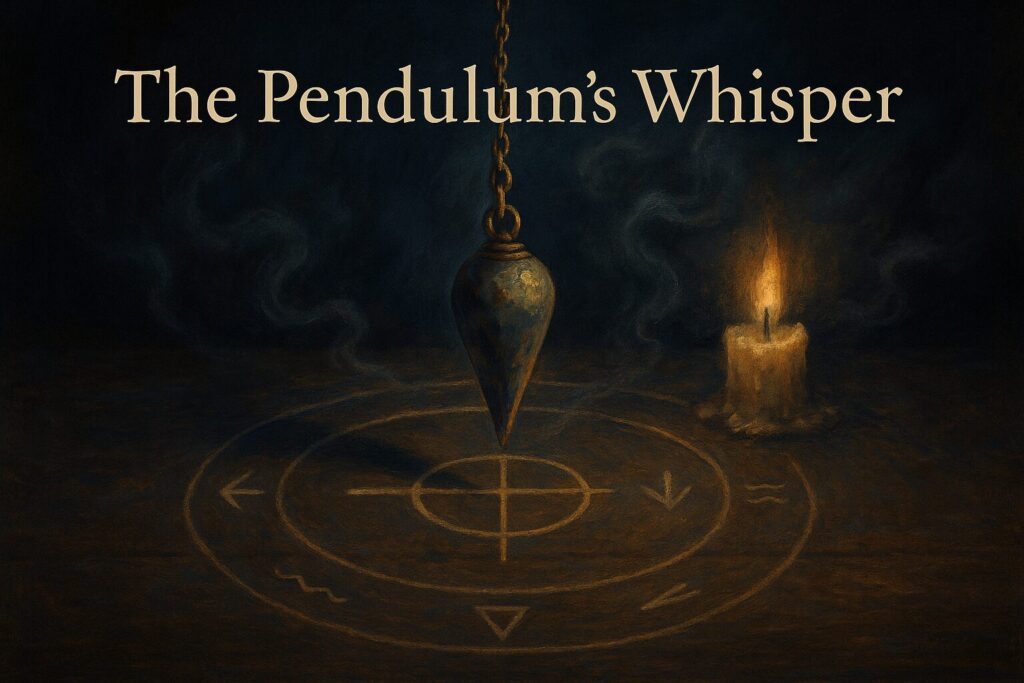Dowsing and Pendulum

To watch a pendulum swing or a rod bend is to witness the subtle dialogue between spirit, earth, and body. Dowsing — sometimes called radiesthesia — is among the oldest forms of divination, rooted in the conviction that life itself moves through invisible currents. Where the Tarot speaks in symbols and oracle cards whisper in archetypes, dowsing answers through motion — through the gentle quiver of metal, the tilt of a crystal, the turn of a wrist. It is not about sight, but about sensitivity.
Historically, dowsing arose as a practical and sacred art. In medieval Europe, miners sought ore and treasure by tracing unseen lines in the earth’s energy field. The Church alternately condemned and tolerated the practice, viewing it as superstition or miracle depending on context. By the Renaissance, dowsing had spread widely — adopted by alchemists, natural magicians, and healers who believed the world was a body pulsing with vital currents. The dowser was its nerve, responding instinctively to what lay beneath or beyond ordinary perception.
The tool itself varies by tradition. The classic Y-rod, cut from hazel, willow, or peach, splits into two branches held loosely in the hands, dipping when the sought energy is found. Later came the L-rods — twin metal arms that cross or uncross in response to subtle magnetic shifts. And then the pendulum, a small weight suspended on a thread or chain, whose swing reveals yes and no, left and right, or degrees of intensity. Each device translates invisible resonance into visible motion. The tool is merely an amplifier; the true antenna is the dowser’s own nervous system attuned to the unseen.
To understand dowsing is to understand that the body itself is a divinatory instrument. The pendulum does not move on its own; it responds to micro-movements created by intuition, instinct, or subtle electromagnetic response. Modern physics might call it the ideomotor effect; the mystic calls it the soul’s whisper through the hand. Both are true. Dowsing bridges matter and mind, proof that the invisible can shape the physical without force.
In magical and spiritual contexts, dowsing evolved far beyond its earthy origins. Pendulum work became a means of communication — not only for water or minerals, but for truth, emotion, and spirit. Practitioners used it to test herbs, divine energy blockages, identify the presence of spirits, or choose between options when logic failed. Energy mapping, a close cousin, used rods or pendulums to sense ley lines, sacred wells, or the energetic heart of a ritual space. The craft of the witch and the work of the geomancer overlap here: both listen to the landscape’s pulse.
Within Witchcraft and Wicca, dowsing is both diagnostic and devotional. A witch might pendulate above a spell’s components to confirm alignment, test the vibration of an herb before blending, or sense the right moment to seal a charm. Dowsing can also aid in healing — locating points of imbalance in the aura or determining which crystals or colors restore harmony. During coven rituals, pendulums are sometimes used collectively, each witch lending energy to the question so that the tool’s motion becomes a visible expression of group intuition. It is an art of collective attunement, where will and energy merge into one rhythm.
Other forms of kinetic divination share the same principle of motion revealing meaning. The talking board or planchette traces letters under spirit guidance. Flame-reading — watching how a candle flickers, sways, or crackles — interprets air currents and energy shifts as answers. Oomancy, the divination by egg whites dropped into water, reads the coiling filaments of protein as physical echoes of unseen forces. Even the swing of smoke from incense or the flutter of a leaf in ritual air can serve as oracles to the practiced eye. In every case, the divine speaks through movement.
A simple example illustrates the intimacy of the craft. A practitioner holds a pendulum over a map and asks, “Where is the source of this spring?” The pendulum trembles, then circles slowly over a single point. The dowser marks it, follows intuition, and finds the water exactly there. Another witch might hold the pendulum above her heart and ask, “Is my energy aligned with this path?” The pendulum’s spin steadies or wavers — not commanding her choice, but reflecting what her deeper knowing already feels.
Like all divinatory arts, dowsing requires respect and calibration. Before beginning, practitioners establish what direction means yes, what means no, and cleanse the tool with breath or smoke to ensure clarity. The pendulum should never dictate, only confirm. A wise dowser cross-checks results, grounding between questions, ensuring that what moves the pendulum is intuition, not anxiety or bias. This discipline transforms a simple object into an oracle.
Dowsing, at its purest, teaches that knowledge moves. Truth is not static but rhythmic, sensed through resonance rather than decree. Whether seeking water deep in the soil or wisdom deep in the self, the dowser’s gift is receptivity — the courage to still the mind until even the smallest motion becomes revelation. The pendulum’s arc, the rod’s subtle twitch, the breath of air across a candle flame — all are signs that the world is alive, responsive, and ready to answer those who learn to ask with steady hands and open hearts.

